Recent Articles
Popular Makes
Body Types
2016 Mazda CX-5 Road Test and Review
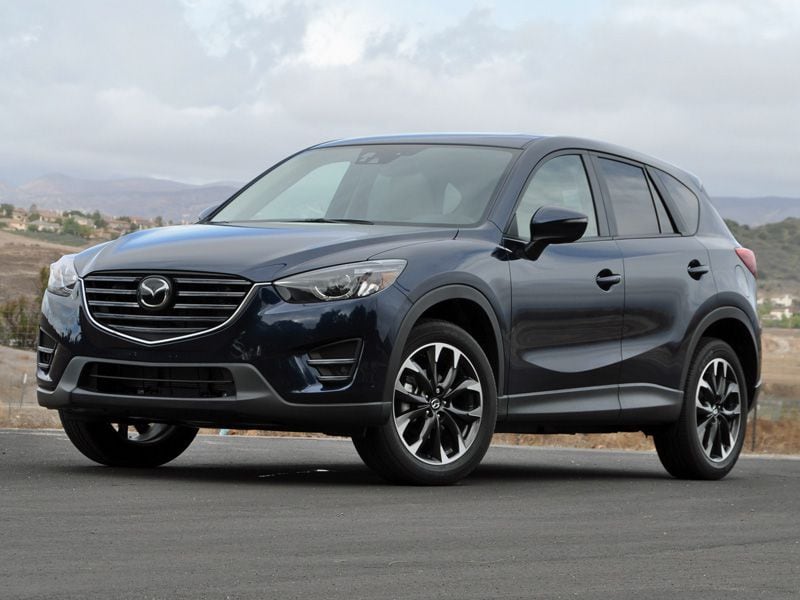
ABTL 2016 Mazda CX 5 Grand Touring Front Quarter Left
Mazda is crushing it. One of the world’s smallest independent automakers, Mazda divorced Ford Motor Company several years ago, forcing the organization to focus, and hard, on what matters. As it turns out, what matters to Mazda is driving dynamics, efficiency, and useful safety and infotainment technologies, all wrapped in alluring and modern design.
People are noticing Mazda. In 2015, the company enjoyed its best annual sales in 20 years, and a redesigned CX-9 midsize crossover debuted at the Los Angeles Auto Show, representing the final box to be checked in the automaker’s reinvention, one that began in 2013 with the compact crossover pictured here: the Mazda CX-5.
Now the oldest vehicle in Mazda’s lineup, the 2016 CX-5 is freshened up with subtle exterior styling changes, minor interior modifications, equipment changes, drivetrain and suspension tweaks, a new infotainment system, and additional safety technologies. I put the CX-5 to the test as a suburban family shuttle to see how well it is holding up, and how the changes impact driver satisfaction. After a week of kid-hauling and grocery-getting, it is easy to understand this Mazda’s continued popularity.
More Standard Equipment, More Options
Mazda CX-5 buyers choose between Sport, Touring, and Grand Touring trim levels with front-wheel or all-wheel drive. New standard equipment includes Bluetooth connectivity and an electronic parking brake, and the automatic transmission gains a Sport driving mode. Halfway through the model year, Mazda decided to add its Mazda Connect infotainment system and a reversing camera to Sport models equipped with an automatic transmission. Previously, this was an option.
Mazda made another mid-year change to the CX-5 Touring model, equipping it with standard heated seats and a navigation system. A set of adaptive LED headlights, fog lights, and taillights is a new option for the CX-5 Touring, packaged with rain-sensing wipers and Mazda’s Smart City Brake Support low-speed collision warning and automatic emergency braking system.
Grand Touring models also get a standard navigation system, plus new 19-inch aluminum wheels. It, too, can be fitted with LED lighting and Smart City Brake Support, and is exclusively offered with a new i-ActiveSense suite of safety systems. My fully loaded, Deep Crystal Blue test vehicle had Grand Touring trim, all of these upgrades, plus a cargo area tray, for a total of $32,180.
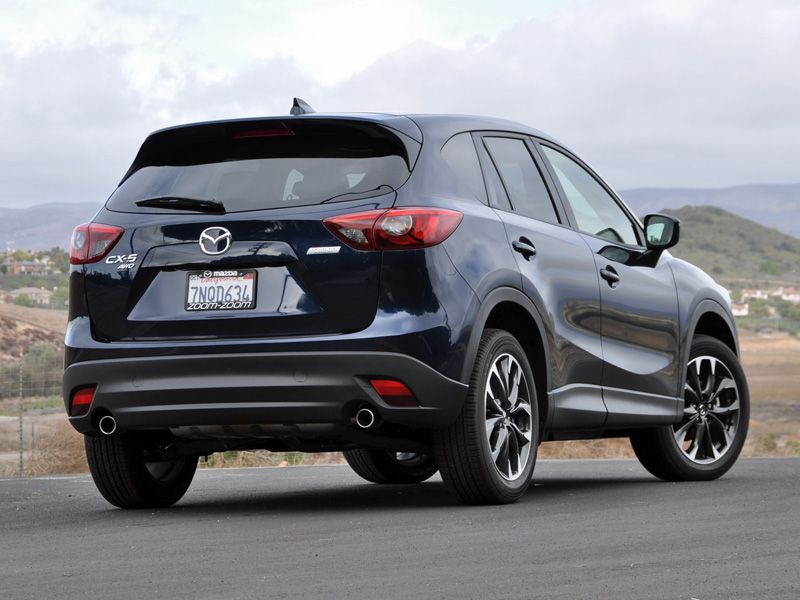
Photo by Christian Wardlaw
Sophistication, Style and Substance Elevate the CX-5
Styling, according to J.D. Power research, is the second biggest reason car buyers choose a specific make and model when they buy a new vehicle. That helps to explain how an underdog like Mazda is doing so well in a highly competitive market. Everything the company builds exudes sophistication, style, and substance, and in Grand Touring trim the 2016 Mazda CX-5 might as well be an entry-luxury crossover.
Though changes for the 2016 CX-5 Grand Touring are limited to a new grille, revised headlights and taillights with available LED lighting, and new dark-painted 19-inch aluminum wheels with a machined outer surface, the collective effect produces a more mature appearance.
Delivering a simple, clean, and upscale aesthetic, the cabin’s updated materials and trim ooze refinement and class. My test vehicle’s Parchment leather seats and door panel inserts, nearly white and providing stark contrast against the black carpeting and dashboard, served to heighten the sensation of luxury. I strongly recommend this interior color, though dark rinse jeans are likely to discolor the leather.
Taken together, the Grand Touring model’s exterior detailing and interior upgrades make the CX-5’s sticker price seem like a bargain.
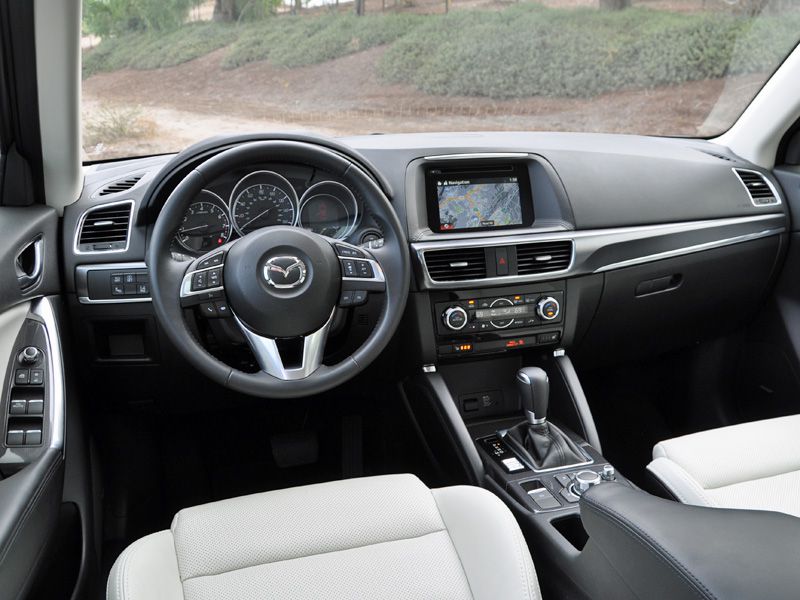
Photo by Christian Wardlaw
Two Engines + Two Transmissions + Two Drivetrains = Meh
As befits a Mazda, the CX-5 is available with a 6-speed manual gearbox. However, to get it, you must settle for the basic Sport model with front-wheel drive, which comes in three drab paint colors and without factory options. Also, this is the only version of the CX-5 equipped with a 155-horsepower, 2.0-liter 4-cylinder engine. Honestly, I’m not sure why Mazda even bothers with this variant, which adds unnecessary complexity to the lineup and which few dealers order for stock.
When you install an automatic transmission in a CX-5 Sport, you also install a more powerful, 184-horsepower, 2.5-liter 4-cylinder engine. They go hand-in-hand, like peanut butter and chocolate, Brad and Angelina, or T-shirts and khakis. This engine is not quite as refined as the smaller 2.0-liter, but is a better match for the 3,433-pound CX-5’s curb weight, providing decent zoom-zoom when the driver steps on the gas.
Drive the CX-5 with the transmission in Normal mode, and it will upshift rapidly in an effort to conserve fuel. Activate the Sport mode, and the idea is that the CX-5 will feel even more alive. It does, but the transmission tends to hold revs for too long.
Manual shifting can alleviate this, but the gate is mapped to deliver a downshift when you push the selector forward, or up, and an upshift when you pull the selector back, or down. Patterned after F1 racing, this is counterintuitive for a street vehicle. If Mazda offered paddle shifters, you could switch to those and avoid any confusion. But paddle shifters are absent.
Though Mazda says the CX-5 is more efficient this year, my test vehicle failed to deliver the fuel economy that the EPA suggested it would. Official ratings are 26 mpg in the city, 33 mpg on the highway, and 29 mpg in combined driving. I put 500 miles on my front-drive CX-5 test vehicle, more than half of them on freeways, and I averaged 25.5 mpg. That’s a significant shortfall. And, no, I was not in Sport mode the whole time.
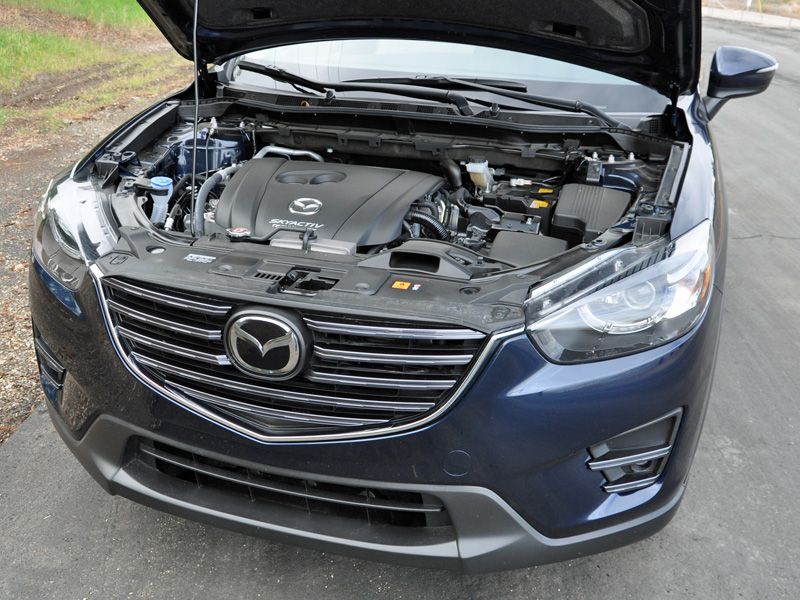
Photo by Christian Wardlaw
Suspension Changes Improve Ride, Not Handling
Normally, Mazda’s expertise shines in the ride and handling department, but the CX-5’s stubby 106.3-inch wheelbase, narrow 62.5-inch track, and relatively high center of gravity evidently vex the automaker’s engineers. My gripe is with the CX-5’s bouncy and choppy behavior when driving on a twisty, undulating road. These traits, combined with Toyo A23 P225/55R19 all-season tires that fail to engender trust, make the CX-5 a helluva lot less fun to drive than, say, a Mazda Mazda3.
In the hopes of delivering a smoother and flatter ride quality, Mazda fiddled with this crossover’s suspension recipe for 2016, The changes appear to be successful, as the 2016 CX-5 feels firmer, tauter, and better connected in the city, remaining solidly planted instead of skittish on less than perfect pavement. The ride quality is not harsh, but neither does the CX-5 glide over road imperfections.
Perhaps the excellence evident in the CX-5’s steering and braking components serves to magnify its handling flaws. Automakers struggling with how to tune electric steering systems should look to Mazda for guidance, and in the CX-5 it feels absolutely natural on-center, agreeably weighted at all times, and sharp enough to place the SUV exactly where the driver wants it. The brakes are just as impressive, providing excellent pedal feel and easy modulation.
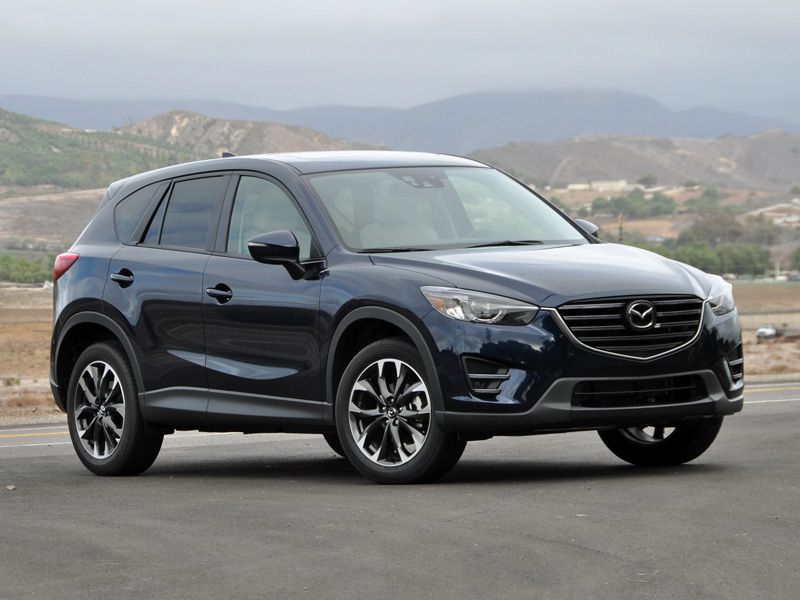
Photo by Christian Wardlaw
Small, Snug, Yet Functional Interior
Among compact crossover SUVs, the Mazda CX-5 resides on the smaller side of the scale in terms of its interior space, supplying less room than competitors such as the Honda CR-V, Toyota RAV4, and Subaru Forester.
Up front, the seats are quite comfortable, and Mazda supplies soft places on the center console and door panel for resting elbows. I’m six feet tall, I weigh 250 pounds, my pants measure 33 inches at the inseam, and I fit perfectly behind the Mazda CX-5’s tilt/telescopic steering wheel. The driving position is a bit snug, though, and if I were a taller person, or a wider person, I would likely skip the CX-5 in favor of something else in this segment.
Snug describes rear seat comfort, too. The bottom cushion is mounted a little low in order to provide a flatter cargo load floor when it is folded down, and shin space is tight for somebody my size. Kids are fine, as long as they’re not in a reverse-facing child safety seat.
In another example of inexplicable and unnecessary complexity, a 60/40-split folding rear seat is standard for the CX-5 Sport, while upgrading to the Touring or Grand Touring model supplies a handy 40/20/40-split folding seat. This latter design allows four passengers to ride in comfort while simultaneously carrying long items, like skis or snowboards, and it ought to be standard on all models.
Cargo space behind the seat measures 34.1 cu.-ft., which is less than the CX-5’s better-selling rivals. Nevertheless, Mazda makes good use of the space, and four full-size suitcases will easily fit, along with a compact folding stroller. Fold the rear seat down for maximum cargo space of 64.8 cu.-ft., a Miata trunk or two’s worth short of segment sales leaders.
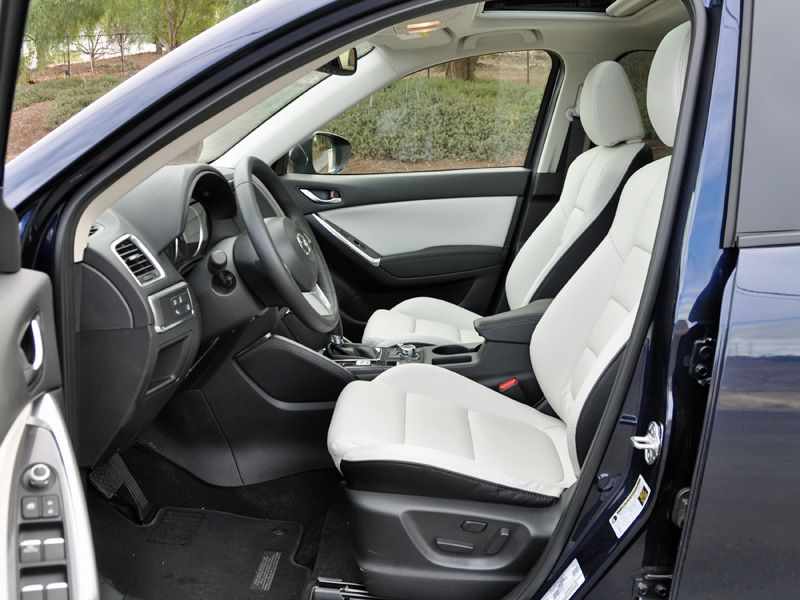
Photo by Christian Wardlaw
More Safety Features, Downgraded Safety Score
Strangely, the 2016 Mazda CX-5 performs worse in federal government crash tests than did the 2015 model. Last year, the CX-5 got a 5-star rating for front passenger protection in a frontal collision. This year, that rating drops to 3 stars, which also impacts the overall rating, bringing it down to 4 stars. I’ve asked Mazda about this on several occasions, and each time the automaker tells me it is investigating the reason for this downgrade.
On a positive note, however, the CX-5 does earn a “Top Safety Pick” rating from the Insurance Institute for Highway Safety (IIHS), and when it is equipped with automatic emergency braking technology, it gets a “Top Safety Pick+” rating.
Mazda offers two different versions of automatic emergency braking on the CX-5, just as it offers two engines, two transmissions, and two rear seat configurations. Smart City Brake Support works at low speeds, is part of the Technology Package on Touring and Grand Touring models, and earns the CX-5 an “Advanced” front crash prevention rating. Smart Brake Support with Collision Warning is new for 2016, works at higher speeds, and is exclusive to the Grand Touring model’s i-ActiveSense Package. With it, the CX-5 gets a “Superior” front crash prevention rating.
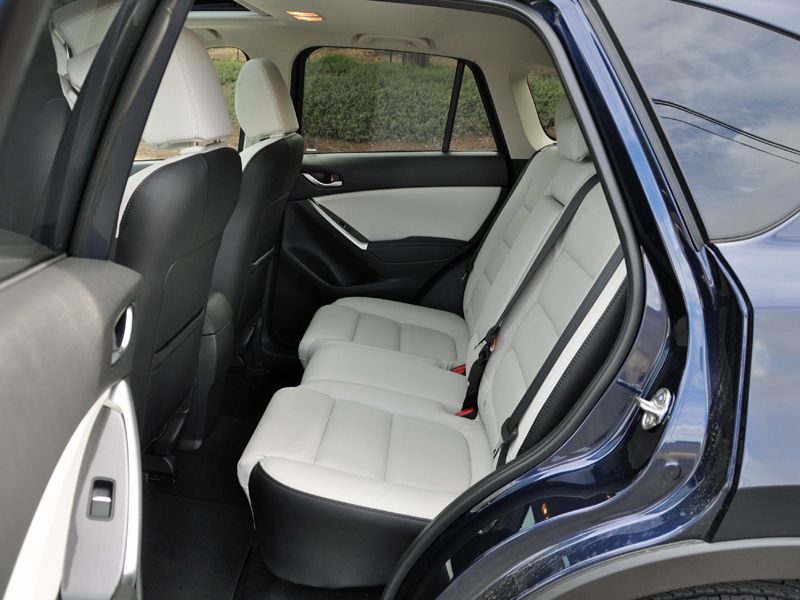
Photo by Christian Wardlaw
Mazda Connect Has a Steep Learning Curve
Representing a huge improvement over the CX-5’s previous infotainment technology, the new Mazda Connect system responds to touch, voice control, center console controls, and buttons on the steering wheel. It takes awhile to get the system set up to personal preferences, to acclimate to how the center console controls work, and to remember that once the vehicle is underway, the touch-sensing display screen no longer responds to touch commands. Once you have everything sorted out, though, it is easy to use Mazda Connect’s myriad functions.
Highlights include access to supported Internet radio platforms and social media feeds, text message delivery and response, and an E911 automatic collision notification service. Navigation is included for the Touring and Grand Touring models, complete with topographically detailed maps, and a Bose Centerpoint premium surround sound system is available.
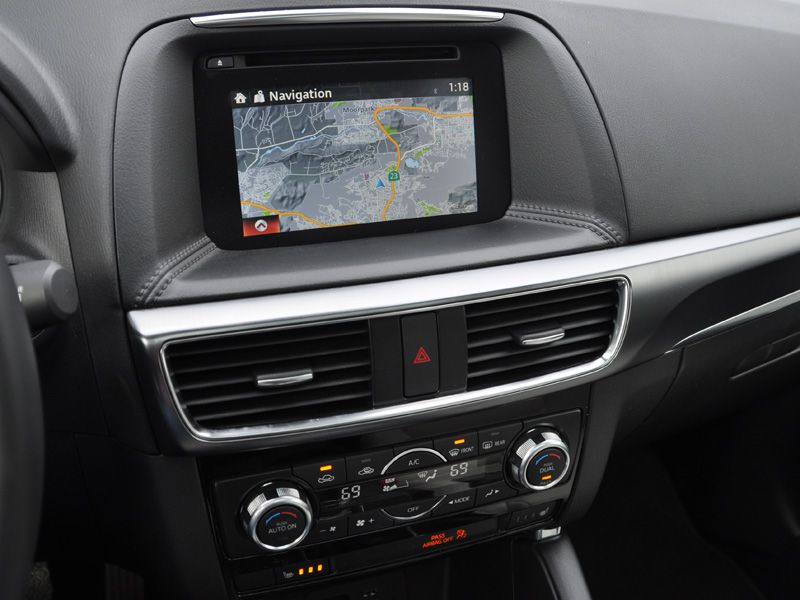
Photo by Christian Wardlaw
Better Than Ever, Yet Still Imperfect
While the 2016 Mazda CX-5 is better than ever, it is imperfect. The change in federal government crash-test ratings troubles me, as does the dramatic shortfall in terms of observed fuel economy. Though comfortable and supplying impressive utility, the interior is smaller than the best-selling compact crossovers. Finally, while it is more nimble and engaging to drive than most of its competitors, the CX-5’s driving dynamics pale in comparison to the lighter and lower Mazda Mazda3 with which it shares its platform.
Still, a Mazda Mazda3 is even smaller inside, with less cargo room, and it can’t match the CX-5’s 8.5 inches of ground clearance. The CX-5 is undeniably stylish in a segment where form typically follows function, it is fundamentally fun to drive (for a crossover), and while the NHTSA rates it lower in terms of safety, the IIHS thinks this Mazda will protect you and your family like few others.

Photo by Christian Wardlaw
2016 Mazda CX-5 Pros and Cons
- Exterior styling and interior materials
- Quick, nimble, enjoyable urban driving dynamics
- Top safety rating from the IIHS
- Mazda Connect infotainment system
- Drop in NHTSA crash-test rating
- Real-world fuel economy
- Passenger and cargo space
- Unnecessary packaging complexity
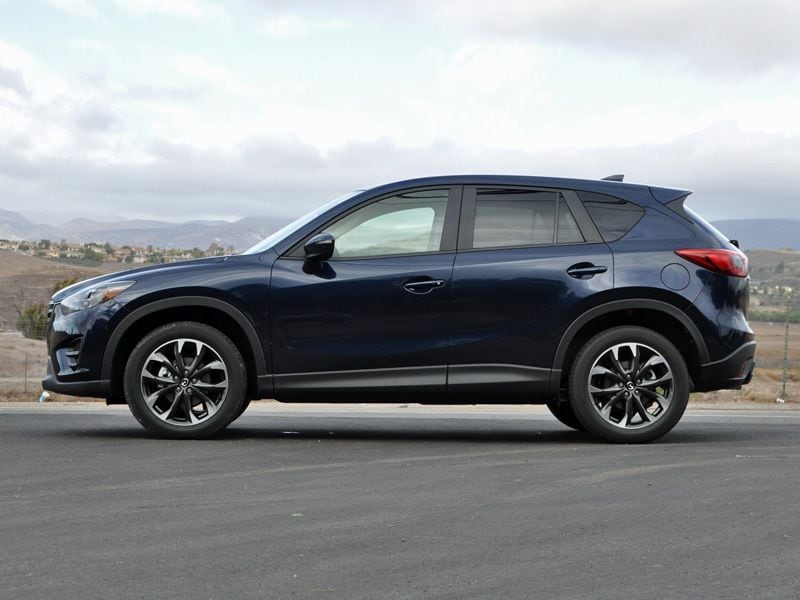
Photo by Christian Wardlaw